Capacitor
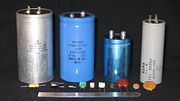


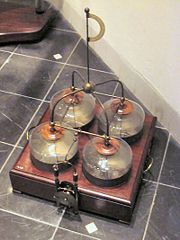
A capacitor is a passive electrical component that can store energy in the electric field between a pair of conductors (called "plates"). The process of storing energy in the capacitor is known as "charging", and involves electric charges of equal magnitude, but opposite polarity, building up on each plate. A capacitor's ability to store charge is measured by its capacitance, in units of farads.
Capacitors are often used in electric and electronic circuits as energy-storage devices. They can also be used to differentiate between high-frequency and low-frequency signals. This property makes them useful in electronic filters. Practical capacitors have series resistance, internal leakage of charge, series inductance and other non-ideal properties not found in a theoretical, ideal, capacitor.
Capacitors are occasionally referred to as condensers. This term is considered archaic in English, but most other languages use a cognate of condenser to refer to a capacitor.
A wide variety of capacitors (see photos) have been invented, including small electrolytic capacitors used in electronic circuits, basic parallel-plate capacitors, mechanical variable capacitors, and the early Leyden jars, among numerous other types of capacitors.
Contents |
History

In October 1745, Ewald Georg von Kleist of Pomerania in Germany invented the first recorded capacitor: a glass jar with water inside as one plate was held on the hand as the other plate. A wire in the mouth of the bottle received charge from an electric machine, and released it as a spark.[1]
In the same year, Dutch physicist Pieter van Musschenbroek independently invented a very similar capacitor. It was named the Leyden jar, after the University of Leyden where van Musschenbroek worked. Daniel Gralath was the first to combine several jars in parallel into a "battery" to increase the charge storage capacity.
Benjamin Franklin investigated the Leyden jar, and proved that the charge was stored on the glass, not in the water as others had assumed. Leyden jars began to be made by coating the inside and outside of jars with metal foil, leaving a space at the mouth to prevent arcing between the foils. The earliest unit of capacitance was the 'jar', equivalent to about 1 nanofarad.
Leyden jar or flat glass plate construction was used exclusively up until about 1900. Then the invention of wireless (radio) created a demand for standard capacitors, and the steady move to higher frequencies required capacitors with lower inductance. A more compact construction began to be used of a flexible dielectric sheet such as oiled paper sandwiched between sheets of metal foil, rolled or folded into a small package.
Early capacitors were also known as condensers, a term that is still occasionally used today. It was coined by Alessandro Volta in 1782 (derived from the Italian condensatore), with reference to the device's ability to store a higher density of electric charge than a normal isolated conductor. Most non-English European languages still use a word derived from "condensatore".
Theory of operation

A capacitor consists of two conductive electrodes, or plates, separated by a dielectric, which prevents charge from moving directly between the plates. Charge may however move from one plate to the other through an external circuit, such as a battery connected between the terminals.
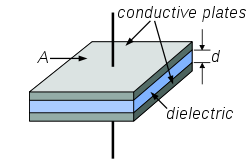
When any external connection is removed, the charge on the plates persists. The separated charges attract each other, and an electric field is present between the plates. The simplest practical capacitor consists of two wide, flat, parallel plates separated by a thin dielectric layer.
Assuming that the plate size  , where
, where  is the area of the plates, is much greater than their separation
is the area of the plates, is much greater than their separation  , the instantaneous electric field between the plates
, the instantaneous electric field between the plates  is identical at any location away from the edges. If the instantaneous charge on a plate,
is identical at any location away from the edges. If the instantaneous charge on a plate,  , is spread evenly, then
, is spread evenly, then
 ,
,
where  is the permittivity of the dielectric. The voltage
is the permittivity of the dielectric. The voltage  between the plates is given by
between the plates is given by
 ,
,
where  is a position between the plates
is a position between the plates
Capacitance

A capacitor's ability to store charge is measured by its capacitance  , the ratio of the amount of charge stored on each plate to the voltage:
, the ratio of the amount of charge stored on each plate to the voltage:
 ,
,
For an ideal parallel plate capacitor with a plate area  and a plate separation
and a plate separation  :
:
In SI units, a capacitor has a capacitance of one farad when one coulomb of charge stored on each plate causes a voltage difference of one volt between its plates. Since the farad is a very large unit, capacitance is usually expressed in microfarads (µF), nanofarads (nF), or picofarads (pF). In general, capacitance is greater in devices with large plate areas, separated by small distances. When a dielectric is present between two charged plates, its molecules become polarized and reduce the internal electric field and hence the voltage. This allows the capacitor to store more charge for a given voltage, so a dielectric increases the capacitance of a capacitor, by an amount given by the dielectric constant,  , of the material.
, of the material.
Energy storage
Work must be done by an external influence to move charge between the plates in a capacitor. When the external influence is removed, the charge separation persists and energy is stored in the electric field. If charge is later allowed to return to its equilibrium position, the energy is released. The work done in establishing the electric field, and hence the amount of energy stored, is given by
The maximum energy that can be stored safely in a capacitor is limited by the breakdown voltage of the capacitor, which is the breakdown field strength of the dielectric material times the dielectric thickness. Due to the scaling of capacitance and breakdown voltage with dielectric thickness, all capacitors made with a particular dielectric have approximately equal maximum energy density, to the extent that the dielectric dominates their volume.[2]
Hydraulic analogy
As electrical circuitry can be modeled by fluid flow, a capacitor can be modeled as a chamber with a flexible diaphragm separating the input from the output. As can be determined intuitively as well as mathematically, this provides the correct characteristics:
- The pressure difference (voltage difference) across the unit is proportional to the integral of the flow (current).
- A steady state current cannot pass through it because the pressure will build up across the diaphragm until it equally opposes the source pressure,
- but a transient pulse or alternating current can be transmitted.
- An overpressure results in bursting of the diaphragm, analogous to dielectric breakdown.
- The capacitance of units connected in parallel is equivalent to the sum of their individual capacitances.
Aging
The capacitance of certain capacitors decreases as the component ages. In ceramic capacitors, this is caused by degradation of the dielectric. The type of dielectric and the ambient operating and storage temperatures are the most significant aging factors, while the operating voltage has a smaller effect. The aging process may be reversed by heating the component above the Curie point. Aging is fastest near the beginning of life of the component, and the device stabilizes over time.[3] Electrolytic capacitors age as the electrolyte evaporates. In contrast with ceramic capacitors, this occurs towards the end of life of the component.
Electric circuits
When a capacitor is connected to a current source, charge is transferred between its plates at a rate  . As the voltage between the plates is proportional to the charge, it follows that
. As the voltage between the plates is proportional to the charge, it follows that
 .
.
Conversely, if a capacitor is connected to a voltage source, the resulting displacement current is given by
 .
.
For example, if one were to connect a 1000 µF capacitor to a voltage source, then increase the sourced voltage at a rate of 2.5 Volts per second, the current flowing through the capacitor would be
 .
.
DC sources

A circuit containing only a resistor, a capacitor, a switch and a constant (DC) voltage source  in series is known as a charging circuit. From Kirchhoff's voltage law it follows that
in series is known as a charging circuit. From Kirchhoff's voltage law it follows that
 ,
,
where  and
and  are the voltages across the resistor and capacitor respectively. This reduces to a first order differential equation
are the voltages across the resistor and capacitor respectively. This reduces to a first order differential equation
Assuming that the capacitor is initially uncharged, there is no internal electric field, and the initial current is  . This initial condition allows solution of the differential equation as
. This initial condition allows solution of the differential equation as
The corresponding voltage drop across the capacitor is
Therefore, as charge increases on the capacitor plates, the voltage across the capacitor increases, until it reaches a steady-state value of  , and the current drops to zero. Both the current, and the difference between the source and capacitor voltage decay exponentially with respect to time. The time constant of the decay is given by
, and the current drops to zero. Both the current, and the difference between the source and capacitor voltage decay exponentially with respect to time. The time constant of the decay is given by  .
.
AC sources
When connected to an alternating current (AC) voltage source, the voltage across the capacitor varies sinusoidally as
 ,
,
where  is the angular frequency of the source,
is the angular frequency of the source,  is the amplitude of the voltage and
is the amplitude of the voltage and  is the phase. The corresponding displacement current is therefore
is the phase. The corresponding displacement current is therefore
 .
.
The displacement current therefore varies sinusoidally with the same frequency as the voltage. The amplitude is scaled by the product of capacitance and angular frequency, and a 90 degree (quarter cycle) phase shift. Capacitors effectively conduct AC, as the current maintains a constant, nonzero amplitude. This occurs despite charge never passing directly through the dielectric.
Impedance
The ratio of the phasor voltage across a circuit element to the phasor current through that element is called the impedance  . For a capacitor, the impedance is given by
. For a capacitor, the impedance is given by

where  is the capacitive reactance,
is the capacitive reactance,  is the angular frequency, f is the frequency), C is the capacitance in farads, and j is the imaginary unit.
is the angular frequency, f is the frequency), C is the capacitance in farads, and j is the imaginary unit.
While this relation (between the frequency domain voltage and current associated with a capacitor) is always true, the ratio of the time domain voltage and current amplitudes is equal to  only for sinusoidal (AC) circuits in steady state.
only for sinusoidal (AC) circuits in steady state.
See derivation Deriving capacitor impedance.
Hence, capacitive reactance is the negative imaginary component of impedance. The negative sign indicates that the current leads the voltage by 90° for a sinusoidal signal, as opposed to the inductor, where the current lags the voltage by 90°.
The impedance is analogous to the resistance of a resistor. The impedance of a capacitor is inversely proportional to the frequency - that is, for very high-frequency alternating currents the reactance approaches zero - so that a capacitor is nearly a short circuit to a very high frequency AC source. Conversely, for very low frequency alternating currents, the reactance increases without bound so that a capacitor is nearly an open circuit to a very low frequency AC source. This frequency dependent behaviour accounts for most uses of the capacitor (see "Applications", below).
Reactance is so called because the capacitor does not dissipate power, but merely stores energy. In electrical circuits, as in mechanics, there are two types of load, resistive and reactive. Resistive loads (analogous to an object sliding on a rough surface) dissipate the energy delivered by the circuit as heat, while reactive loads (analogous to a spring or frictionless moving object) store this energy, ultimately delivering the energy back to the circuit.
Also significant is that the impedance is inversely proportional to the capacitance, unlike resistors and inductors for which impedances are linearly proportional to resistance and inductance respectively. This is why the series and shunt impedance formulae (given below) are the inverse of the resistive case. In series, impedances sum. In parallel, conductances sum.
Laplace equivalent (s-domain)
When using the Laplace transform in circuit analysis, the capacitive impedance is represented in the s domain by:

where C is the capacitance, and s (= σ+jω) is the complex frequency.
Displacement current
The physicist James Clerk Maxwell invented the concept of displacement current, dD/dt, to make Ampère's law consistent with conservation of charge in cases where charge is accumulating as in a capacitor. He interpreted this as a real motion of charges, even in vacuum, where he supposed that it corresponded to motion of dipole charges in the aether. Although this interpretation has been abandoned, Maxwell's correction to Ampère's law remains valid.
Limitations due to AC displacement current
The displacement current due to an applied AC voltage source can cause damage to capacitors that are not appropriate for such applications. This current can cause overheating of the capacitor due to the power dissipated across the capacitor's Equivalent Series Resistance (ESR). As the frequency of the AC voltage source increases the more power will be dissipated across the ESR due to the increase in current flow required to charge and discharge the capacitor in a shorter time period.
Ceramic capacitors are well suited for frequency applications due to their low ESR values. However, most tantalum capacitors are rated for a maximum ripple current due to their much higher ESR values.
The electric current, , and electric power,
, and electric power,  produced by an AC voltage source across a capacitor is given as:
produced by an AC voltage source across a capacitor is given as:

![P_{RMS} = V_{RMS}I_{RMS} = \frac{{V_{ESR}}^2}{R_{ESR}} = \frac{{V_{RMS}}^2 R_{ESR}}{{R_{ESR}}^2 + [\frac{1}{2 \pi fC}]^2}\!](/2009-wikipedia_en_wp1-0.7_2009-05/I/a3f62317b5494349ba709190a17ace65.png)

Networks
Series or parallel arrangements
Capacitors in a parallel configuration each have the same potential difference (voltage). Their total capacitance (Ceq) is given by:
The reason for putting capacitors in parallel is to increase the total amount of charge stored. In other words, increasing the capacitance also increases the amount of energy that can be stored. Its expression is:
The current through capacitors in series stays the same, but the voltage across each capacitor can be different. The sum of the potential differences (voltage) is equal to the total voltage. Their total capacitance is given by:
In parallel, the effective area of the combined capacitor has increased, increasing the overall capacitance. However, in series, the distance between the plates has effectively been increased, reducing the overall capacitance.
Capacitors are used in series for higher working voltage, for example for smoothing in a high voltage power supply. Three "600 volt maximum" capacitors in series can be used at 1800 volts. This is offset by the total capacitance obtained being only one third of the value of the capacitors used. This can be countered by connecting 3 of these series set-ups in parallel, resulting in a 3x3 matrix of capacitors with the same overall capacitance as an individual capacitor but operable under three times the voltage. In this application, a large resistor would be connected across each capacitor to ensure that the total voltage is divided equally across each capacitor and also to discharge the capacitors for safety when the equipment is not in use.
Another application is for use of polarized capacitors in alternating current circuits; the capacitors are connected in series, in reverse polarity, so that at any given time one of the capacitors is not conducting.
Capacitor/inductor duality
In mathematical terms, the ideal capacitor can be considered as an inverse of the ideal inductor, because the voltage-current equations of the two devices can be transformed into one another by exchanging the voltage and current terms. Just as two or more inductors can be magnetically coupled to make a transformer, two or more charged conductors can be electrostatically coupled to make a capacitor. The mutual capacitance of two conductors is defined as the current that flows in one when the voltage across the other changes by unit voltage in unit time.
Capacitor types
Practical capacitors are available commercially in many different forms. The type of internal dielectric, the structure of the plates and the device packaging all strongly affect the characteristics of the capacitor, and its applications.
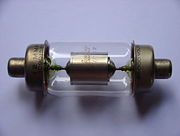
Dielectric materials
Most types of capacitor include a dielectric spacer, which increases their capacitance. These dielectrics are most often insulators. However, low capacitance devices are available with a vacuum between their plates, which allows extremely high voltage operation and low losses. Variable capacitors with their plates open to the atmosphere were commonly used in radio tuning circuits. Later designs use polymer foil dielectric between the moving and stationary plates, with no significant air space between them.
Several solid dielectrics are available, including paper, plastic, glass, mica and ceramic materials. Paper was used extensively in older devices and offers relatively high voltage performance. However, it is susceptible to water absorption, and has been largely replaced by plastic film capacitors. Plastics offer better stability and aging performance, which makes them useful in timer circuits, although they may be limited to low operating temperatures and frequencies. Ceramic capacitors are generally small, cheap and useful for high frequency applications, although their capacitance varies strongly with voltage, and they age poorly. They are broadly categorized as Class 1 dielectrics, which have predictable variation of capacitance with temperature or Class 2 dielectrics, which can operate at higher voltage. Glass and mica capacitors are extremely reliable, stable and tolerant to high temperatures and voltages, but are too expensive for most mainstream applications.
Electrolytic capacitors use an aluminum or tantalum plate with an oxide dielectric layer. The second electrode is a liquid electrolyte, connected to the circuit by another foil plate. Electrolytic capacitors offer very high capacitance but suffer from poor tolerances, high instability, gradual loss of capacitance especially when subjected to heat, and high leakage current. The conductivity of the electrolyte drops at low temperatures, which increases equivalent series resistance. While widely used for power-supply conditioning, poor high-frequency characteristics make them unsuitable for many applications. Tantalum capacitors offer better frequency and temperature characteristics than aluminum, but higher dielectric absorption and leakage.[4] OS-CON (or OC-CON) capacitors are a polymerized organic semiconductor solid-electrolyte type that offer longer life at higher cost than standard electrolytic capacitors.
Several other types of capacitor are available for specialist applications. Supercapacitors made from carbon aerogel, carbon nanotubes, or highly porous electrode materials offer extremely high capacitance (as much as 2,500 farads) and can be used in some applications instead of rechargeable batteries. Alternating current capacitors are specifically designed to work on line (mains) voltage AC power circuits. They are commonly used in electric motor circuits and are often designed to handle large currents, so they tend to be physically large. They are usually ruggedly packaged, often in metal cases that can be easily grounded/earthed. They also tend to have rather high direct current breakdown voltages.
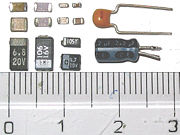
Structure
The arrangement of plates and dielectric has many variations depending on the desired ratings of the capacitor. For small values of capacitance (microfarads and less), ceramic disks use metallic coatings, with wire leads bonded to the coating. Larger values can be made by multiple stacks of plates and disks. Larger value capacitors usually use a metal foil or metal film layer deposited on the surface of a dielectric film to make the plates, and a dielectric film of impregnated paper or plastic - these are rolled up to save space. To reduce the series resistance and inductance for long plates, the plates and dielectric are staggered so that connection is made at the common edge of the rolled-up plates, not at the ends of the foil or metalized film strips that comprise the plates.
The assembly is encased to prevent moisture entering the dielectric - early radio equipment used a cardboard tube sealed with wax. Modern paper or film dielectric capacitors are dipped in a hard thermoplastic. Large capacitors for high-voltage use may have the roll form compressed to fit into a rectangular metal case, with bolted terminals and bushings for connections. The dielectric in larger capacitors is often impregnated with a liquid to improve its properties.
Capacitors may have their connecting leads arranged in many configurations, for example axially or radially. "Axial" means that the leads are on a common axis, typically the axis of the capacitor's cylindrical body -- the leads extend from opposite ends. Radial leads might more accurately be referred to as tandem; they are rarely actually aligned along radii of the body's circle, so the term is inexact, although universal. The leads (until bent!) are usually in planes parallel to that of the flat body of the capacitor, and extend in the same direction; they are often parallel as manufactured.
Small, cheap discoidal ceramic capacitors have existed since the 1930s, and remain in widespread use. Since the 1980s, surface mount packages for capacitors have been widely used. These packages are extremely small and lack connecting leads, allowing them to be soldered directly onto the surface of printed circuit boards. Surface mount components avoid undesirable high-frequency effects due to the leads and simplify automated assembly, although manual handling is made difficult due to their small size.
Mechanically controlled variable capacitors allow the plate spacing to be adjusted, for example by rotating or sliding a set of movable plates into alignment with a set of stationary plates. Low cost variable capacitors squeeze together alternating layers of aluminum and plastic with a screw. Electrical control of capacitance is achievable with varactors (or varicaps), which are reverse-biased semiconductor diodes whose depletion region width varies with applied voltage. They are used in phase-locked loops, amongst other applications.
Applications
Capacitors have various uses in electronic and electrical systems.
Energy storage
A capacitor can store electric energy when disconnected from its charging circuit, so it can be used like a temporary battery. Capacitors are commonly used in electronic devices to maintain power supply while batteries are being changed. (This prevents loss of information in volatile memory.)
In car audio systems, large capacitors ranging from 0.5 to over 100 farads are used to store energy for the amplifier to use on demand.
UPSes can be equipped with maintenance-free capacitors to extend service life.[5]
| Capacitor | Polarized capacitors |
Variable capacitor |
|---|---|---|
|
|
Pulsed power and weapons
Groups of large, specially constructed, low-inductance high-voltage capacitors (capacitor banks) are used to supply huge pulses of current for many pulsed power applications. These include electromagnetic forming, Marx generators, pulsed lasers (especially TEA lasers), pulse forming networks, radar, fusion research, and particle accelerators.
Large capacitor banks(Reservoir) are used as energy sources for the exploding-bridgewire detonators or slapper detonators in nuclear weapons and other specialty weapons. Experimental work is under way using banks of capacitors as power sources for electromagnetic armour and electromagnetic railguns or coilguns.
Power conditioning
Reservoir capacitors are used in power supplies where they smooth the output of a full or half wave rectifier. They can also be used in charge pump circuits as the energy storage element in the generation of higher voltages than the input voltage.
Capacitors are connected in parallel with the power circuits of most electronic devices and larger systems (such as factories) to shunt away and conceal current fluctuations from the primary power source to provide a "clean" power supply for signal or control circuits. Audio equipment, for example, uses several capacitors in this way, to shunt away power line hum before it gets into the signal circuitry. The capacitors act as a local reserve for the DC power source, and bypass AC currents from the power supply. This is used in car audio applications, when a stiffening capacitor compensates for the inductance and resistance of the leads to the lead-acid car battery.
Power factor correction
In electric power distribution, capacitors are used for power factor correction. Such capacitors often come as three capacitors connected as a three phase load. Usually, the values of these capacitors are given not in farads but rather as a reactive power in volt-amperes reactive (VAr). The purpose is to counteract inductive loading from devices like electric motors and transmission lines to make the load appear to be mostly resistive. Individual motor or lamp loads may have capacitors for power factor correction, or larger sets of capacitors (usually with automatic switching devices) may be installed at a load center within a building or in a large utility substation.
Filtering
Signal coupling
Because capacitors pass AC but block DC signals (when charged up to the applied dc voltage), they are often used to separate the AC and DC components of a signal. This method is known as AC coupling or "capacitive coupling". Here, a large value of capacitance, whose value need not be accurately controlled, but whose reactance is small at the signal frequency, is employed.
Decoupling
A decoupling capacitor is a capacitor used to decouple one part of a circuit from another. Noise caused by other circuit elements is shunted through the capacitor, reducing the effect they have on the rest of the circuit. It is most commonly used between the power supply and ground. An alternative name is bypass capacitor as it is used to bypass the power supply or other high impedance component of a circuit.
Noise filters and snubbers
When an inductive circuit is opened, the current through the inductance collapses quickly, creating a large voltage across the open circuit of the switch or relay. If the inductance is large enough, the energy will generate a spark, causing the contact points to oxidize, deteriorate, or sometimes weld together, or destroying a solid-state switch. A snubber capacitor across the newly opened circuit creates a path for this impulse to bypass the contact points, thereby preserving their life; these were commonly found in contact breaker ignition systems, for instance. Similarly, in smaller scale circuits, the spark may not be enough to damage the switch but will still radiate undesirable radio frequency interference (RFI), which a filter capacitor absorbs. Snubber capacitors are usually employed with a low-value resistor in series, to dissipate energy and minimize RFI. Such resistor-capacitor combinations are available in a single package.
Capacitors are also used in parallel to interrupt units of a high-voltage circuit breaker in order to equally distribute the voltage between these units. In this case they are called grading capacitors.
In schematic diagrams, a capacitor used primarily for DC charge storage is often drawn vertically in circuit diagrams with the lower, more negative, plate drawn as an arc. The straight plate indicates the positive terminal of the device, if it is polarized (see electrolytic capacitor).
Motor starters
In single phase squirrel cage motors, the primary winding within the motor housing isn't capable of starting a rotational motion on the rotor, but is capable of sustaining one. To start the motor, a secondary winding is used in series with a non-polarized starting capacitor to introduce a lag in the sinusoidal current through the starting winding. When the secondary winding is placed at an angle with respect to the primary winding, a rotating electric field is created. The force of the rotational field is not constant, but is sufficient to start the rotor spinning. When the rotor comes close to operating speed, a centrifugal switch (or current-sensitive relay in series with the main winding) disconnects the capacitor. The start capacitor is typically mounted to the side of the motor housing. These are called capacitor-start motors, and have relatively high starting torque. There are also capacitor-run induction motors which have a permanently-connected phase-shifting capacitor in series with a second winding. The motor is much like a two-phase induction motor.
Motor-starting capacitors are typically non-polarized electrolytic types, while running capacitors are conventional paper or plastic film dielectric types.
Signal processing
The energy stored in a capacitor can be used to represent information, either in binary form, as in DRAMs, or in analogue form, as in analog sampled filters and CCDs. Capacitors can be used in analog circuits as components of integrators or more complex filters and in negative feedback loop stabilization. Signal processing circuits also use capacitors to integrate a current signal.
Tuned circuits
Capacitors and inductors are applied together in tuned circuits to select information in particular frequency bands. For example, radio receivers rely on variable capacitors to tune the station frequency. Speakers use passive analog crossovers, and analog equalizers use capacitors to select different audio bands.
The resonant frequency f of a tuned circuit is a function of the inductance (L) and capacitance (C) in series, and is given by:
where L is in henries and C is in farads.
Sensing
Most capacitors are designed to maintain a fixed physical structure. However, various factors can change the structure of the capacitor; the resulting change in capacitance can be used to sense those factors.
Changing the dielectric: The effects of varying the physical and/or electrical characteristics of the dielectric can also be of use. Capacitors with an exposed and porous dielectric can be used to measure humidity in air. Capacitors are used to accurately measure the fuel level in airplanes; as the fuel covers more of a pair of plates, the circuit capacitance increases.
Changing the distance between the plates: Capacitors with a flexible plate can be used to measure strain or pressure. Industrial pressure transmitters used for process control use pressure-sensing diagphragms, which form a capacitor plate of an oscillator circuit. Capacitors are used as the sensor in condenser microphones, where one plate is moved by air pressure, relative to the fixed position of the other plate. Some accelerometers use MEMS capacitors etched on a chip to measure the magnitude and direction of the acceleration vector. They are used to detect changes in acceleration, eg. as tilt sensors or to detect free fall, as sensors triggering airbag deployment, and in many other applications. Some fingerprint sensors use capacitors. Additionally, a user can adjust the pitch of a theremin musical instrument by moving his hand since this changes the effective capacitance between the user's hand and the antenna.
Changing the effective area of the plates: capacitive touch switches [1] [2] [3].
Hazards and safety

Capacitors may retain a charge long after power is removed from a circuit; this charge can cause shocks or damage to connected equipment. For example, even a seemingly innocuous device such as a disposable camera flash unit powered by a 1.5 volt AA battery contains a capacitor which may be charged to over 300 volts. This is easily capable of delivering a shock. Service procedures for electronic devices usually include instructions to discharge large or high-voltage capacitors. Capacitors may also have built-in discharge resistors to dissipate stored energy to a safe level within a few seconds after power is removed. High-voltage capacitors are stored with the terminals shorted, as protection from potentially dangerous voltages due to dielectric absorption.
Some old, large oil-filled capacitors contain polychlorinated biphenyls (PCBs). It is known that waste PCBs can leak into groundwater under landfills. Capacitors containing PCB were labelled as containing "Askarel" and several other trade names. PCB-filled capacitors are found in very old (pre 1975) fluorescent lamp ballasts, and other applications.
High-voltage capacitors may catastrophically fail when subjected to voltages or currents beyond their rating, or as they reach their normal end of life. Dielectric or metal interconnection failures may create arcing that vaporizes dielectric fluid, resulting in case bulging, rupture, or even an explosion. Capacitors used in RF or sustained high-current applications can overheat, especially in the center of the capacitor rolls. Capacitors used within high-energy capacitor banks can violently explode when a short in one capacitor causes sudden dumping of energy stored in the rest of the bank into the failing unit. High voltage vacuum capacitors can generate soft X-rays even during normal operation. Proper containment, fusing, and preventive maintenance can help to minimize these hazards.
High-voltage capacitors can benefit from a pre-charge to limit in-rush currents at power-up of HVDC circuits. This will extend the life of the component and may mitigate high-voltage hazards.
Notes
- ↑ Edwin J. Houston (1905). Electricity in Every-day Life. P. F. Collier & Son. http://books.google.com/books?id=ko9BAAAAIAAJ&pg=PA71&dq=jar+%22von+Kleist%22&lr=&as_brr=1&ei=aniTR_uCJ5HwsgOQ5bU4#PPA71,M1.
- ↑ S. T. Pai and Qi Zhang (1995). Introduction to High Power Pulse Technology. World Scientific. ISBN 9810217145. http://books.google.com/books?id=spZ_H4nwIN0C&pg=PA47&dq=breakdown+field+energy-density+dielectric&ei=bUGySNuEB4XWsgPf_4W8BA&sig=ACfU3U2ooCfDPKtlcl-yPee-vr_jMt6W3A.
- ↑ Ceramic Capacitor Aging Made Simple
- ↑ Ask The Applications Engineer - 21 , Steve Guinta, Analog Devices
- ↑ http://www.industrial-europe.com/showArticle.jhtml?articleID=210602105&cid=NL_industrialeu
References
- Zorpette, Glenn (2005). "Super Charged: A Tiny South Korean Company is Out to Make Capacitors Powerful enough to Propel the Next Generation of Hybrid-Electric Cars". IEEE Spectrum 42 (1): 32. doi:. ISSN 0018-9235. http://www.spectrum.ieee.org/jan05/2777.
- The ARRL Handbook for Radio Amateurs (68th ed ed.). Newington CT USA: The Amateur Radio Relay League. 1991.
- Huelsman, Lawrence P. (1972). Basic Circuit Theory with Digital Computations. Series in computer applications in electrical engineering. Englewood Cliffs: Prentice-Hall. ISBN 0-13-057430-9.
- Philosophical Transactions of the Royal Society LXXII, Appendix 8, 1782 (Volta coins the word condenser)
- A. K. Maini "Electronic Projects for Beginners", "Pustak Mahal", 2nd Edition: March, 1998 (INDIA)
- Spark Museum (von Kleist and Musschenbroek)
- Biography of von Kleist
External links
|
|
See also
|
|
|
|




![v(t) = V_0\left[1-e^{\frac{-t}{RC}}\right]](/2009-wikipedia_en_wp1-0.7_2009-05/I/9458aaf167e40fc8d8d216d1c7ec3ff5.png)





